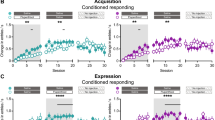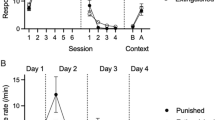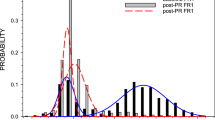Abstract
Response decrements in an operant task produced by either extinction or by the dopamine receptor blocker pimozide were examined in three experiments which employed intermittent reinforcement schedules. In contrast to the congruency between these treatments previously observed following continuous reinforcement training, treatment with pimozide was markedly more effective than extinction in decreasing performance after training with variable interval, fixed interval, and fixed ratio reinforcement. The two treatments also produced substantially different patterns of responding. A shift from extinction to pimozide did not alter the progressive decline in response rate over days, but a shift from pimozide to extinction caused a pronounced increase of performance. These results indicate that the pimozide and extinction treatment did not produce functionally equivalent effects, and that the role of dopamine on reward processes should not be inferred from comparisons between pimozide and extinction.
Similar content being viewed by others
References
Anisman, H., Remington, G., Sklar, L. S.: Effects of inescapable shock on subsequent escape performance: Catecholaminergic and cholinergic modification of response initiation and maintenance. Psychopharmacology 61, 107–124 (1979)
Bindra, D.: A motivational view of learning, performance, and behavior modification. Psychol. Rev. 81, 199–214 (1974)
Bignami, G.: Effects of neuroleptics, ethanol, hypnotic-sedatives, tranquilizers, narcotics, and minor stimulants in aversive paradigms. In: Psychopharmacology of aversively motivated behavior, H. Anisman, G. Bignami, eds., pp. 385–455. New York: Plenum 1978
Bignami, G., Michalek, H.: Cholinergic mechanisms in aversively motivated behavior. In: Psychopharmacology of aversively motivated behavior, H. Anisman, G. Bignami, eds., pp. 173–255. New York: Plenum
Beninger, R. J., Phillips, A. G.: The blockade of conditioned reinforcement by pimozide. Soc. Neurosci. Abstr. 4, 255 (1978)
Fibiger, H. C., Zis, A. P., Phillips, G.: Haloperidol-induced disruption of conditioned avoidance responding: Attenuation by prior training or by anticholinergic drugs. Eur. J. Pharmacol. 30, 309–314 (1975)
Fouriezos, G., Hansson, P., Wise, R. A.: Neuroleptic-induced attenuation of brain stimulation rewards in rats. J. Comp. Physiol. Psychol. 92, 661–671 (1978)
Kirk, R. E.: Experimental design: Procedures for the behavioral sciences. Wadsworth: Betriont 1968
Marshall, J. F., Levitan, D., Stricker, E. M.: Activation-induced restoration of sensorimotor functions in rats with dopamine depleting brain lesions. J. Comp. Physiol. Psychol. 90, 536–546 (1976)
Phillips, A. G., Fibiger, H. C.: Decreased resistance to extinction after haloperidol: Implications for the role of dopamine in reinforcement. Pharmacol. Biochem. Behav. 10, 751–760 (1979)
Rolls, E. T., Rolls, B. J., Kelly, P. H., Shaw, S. G., Wood, R. J., Dale, R.: The relative attenuation of self stimulation, eating, and drinking produced by dopamine receptor blockade. Psychopharmacologia 38, 219–230 (1974)
Stein, L.: Norepinephrine reward pathway: Role in self-stimulation, memory consolidation and schizophrenia. Nebr. Symp. Motiv. 113–159 (1974)
Tombaugh, T. N., Tombaugh, J., Anisman, H.: Effects of dopamine receptor blockade on alimentary behaviors: Home-cage food consumption, magazine training, operant acquisition, and performance. Psychopharmacology 66, 219–226 (1979)
White, N., Brown, Z., Yachnin, M.: Effects of catecholamine manipulations on three different self-stimulation behaviors. Pharmacol. Biochem. Behav. 9, 273–278 (1978)
Wise, R. A., Spindler, J., deWit, H., Gerber, G.: Neuroleptic-induced ‘anhedonia’ in rats: Pimozide blocks the reward quality of focal. Science 201, 262–264 (1978)
Wise, R. A.: Catecholamine theories of reward: A critical review. Brain Res. 152, 215–247 (1978)
Yokel, R. A., Wise, R. A.: Increased lever pressing for amphetamine after pimozide in rats: Implications for a dopamine theory of reward. Science 187, 547–549 (1975)
Yokel, B. A., Wise, R. A.: Attenuating intravenous amphetamine reinforcement by central dopamine blockade in rats. Psychopharmacology 48, 311–318 (1976)
Author information
Authors and Affiliations
Rights and permissions
About this article
Cite this article
Tombaugh, T.N., Anisman, H. & Tombaugh, J. Extinction and dopamine receptor blockade after intermittent reinforcement training: Failure to observe functional equivalence. Psychopharmacology 70, 19–28 (1980). https://doi.org/10.1007/BF00432365
Received:
Accepted:
Issue Date:
DOI: https://doi.org/10.1007/BF00432365




